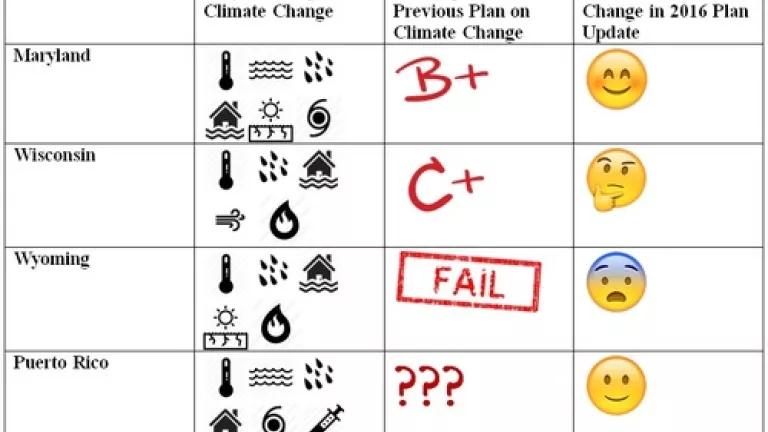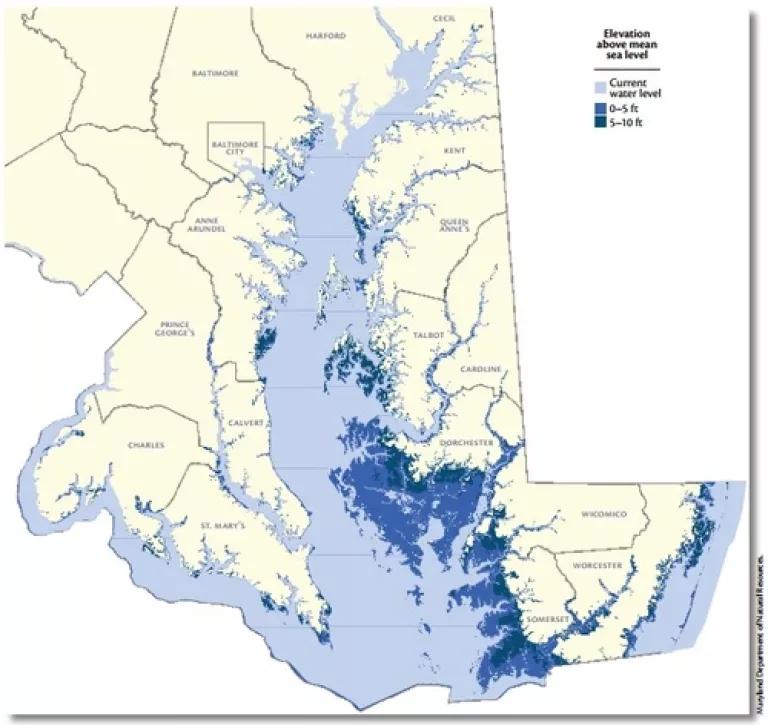Maryland's 2016 Disaster Plan Update: On the Right Track, but There's Room for Improvement (Part 2 of 5)

As I previewed yesterday, this week we're taking an in-depth look at the four U.S. jurisdictions who are required to update their State Hazard Mitigation Plans in 2016 to account for the projected effects of climate change. Today we're looking at Maryland, which is probably the best-positioned of the four to put out a really strong plan.
Deadline for Maryland's plan update: August 2016
Projected climate change impacts:
- According to the National Climate Assessment (NCA), by mid-century, the state is projected to experience many more days per year above 90°F compared to the end of last century.
- Maryland has a highly vulnerable land area because of a higher rate of sea level rise and relatively flat coastline. Models cited in the NCA project 1 to 4 feet of sea level rise by the end of this century. (However, even more could be possible; just up the coast, New York's proposed new sea level rise regulations project up to 6 feet over that time period.) In Maryland, sea level rise is anticipated to affect 298 acres of port facilities, or 32% of the overall port facilities in the state. Sea level rise also increases the risk of damage from storm surge as well as more frequent and severe coastal flooding.
- Winter and spring precipitation is projected to increase. A range of model projections for the end of this century suggests about 5% to 20% increases in winter precipitation, which will more frequently take the form of rain instead of snow. The frequency of heavy downpours is projected to continue to increase as the century progresses, leading to more flooding.
- At the same time, seasonal drought risk is also projected to increase in summer and fall as higher temperatures lead to greater evaporation and earlier winter and spring snowmelt.
- Finally, hurricane-associated storm intensity and rainfall rates are projected to increase as the climate continues to warm.

Sea-level rise vulnerability in the coastal areas of Maryland. Image credit: Maryland Department of Natural Resources.
Does the state's previous hazard mitigation plan take climate change into account?
ON THE RIGHT TRACK: The flood section of Maryland's 2011 plan assesses the probability of future occurrence by both looking at historical flood data and considering how climate change might increase the magnitude of flooding during peak events. The plan goes so far as to quantify what might happen in the future, estimating that the magnitude of peak events could increase 16 to 29 percent. Additionally, the section on sea level rise is based largely on climate projections.
NEEDS WORK: The tropical storms section acknowledges that climate change could affect the frequency and severity of storms, but it says that this impact will be examined in detail in future plans. Similarly, the drought section contains a brief acknowledgment that droughts could increase in the future, but this statement isn't quantified or integrated into the rest of the assessment. The winter storm section notes that snow volumes are predicted to decrease, but this fact isn't reflected in the overall risk assessment.
GRADE: B+. Overall, the 2011 plan's general approach is good; it makes sense to integrate climate change projections into the risk assessment for each hazard (treated as a "risk amplifier"), as opposed to sticking climate change in its own section where it doesn't inform risk assessments or shape decisions (a common flaw in many states' plans). However, there is room for improvement here. For risks where climate change is already considered, updated projections from the past five years can be incorporated. (For example, even in the field of sea level rise, scientific understanding continues to evolve as new studies are released every year.) For other risks, climate change projections should be integrated to the extent feasible.
How much money is at stake?
Between 2010 and 2015, Maryland received almost $35 million through FEMA's hazard mitigation grant programs - funding that was contingent upon the state having an approved hazard mitigation plan.
What can we expect from Maryland in the 2016 plan?
Maryland has been proactive about climate adaptation planning in the past. It has developed at least two climate change strategies, one for sea level rise and coastal storms and another for building societal, economic, and ecological resilience more broadly. These include recommendations for specific actions that can be taken to reduce vulnerability. In addition, state agency staff have announced that the Maryland Department of Natural Resources is leading efforts on a detailed study of sea level rise that will be integrated into the hazard mitigation plan update.
Maryland's governor, Larry Hogan, has not been strong on climate change. Before he was elected, he expressed doubts about the causes of climate change and whether Maryland can do anything to solve the problems associated with it. However, since taking office he hasn't taken any actions yet to stop climate change adaptation efforts from moving forward. When the state legislature passed a bill earlier this year preserving an O'Malley Administration commission dedicated to exploring carbon reduction and adaptation efforts, Hogan announced that he was fine with it. It appears that state agency staff are not being prevented from integrating climate change into the hazard mitigation plan update.
Overall, Maryland is already on the right track, and we're optimistic that Maryland will do a good job integrating more climate data into its 2016 plan. We look forward to working with the state on the plan update.
NEXT UP: Check back tomorrow for a look at what we might expect from Wisconsin.

